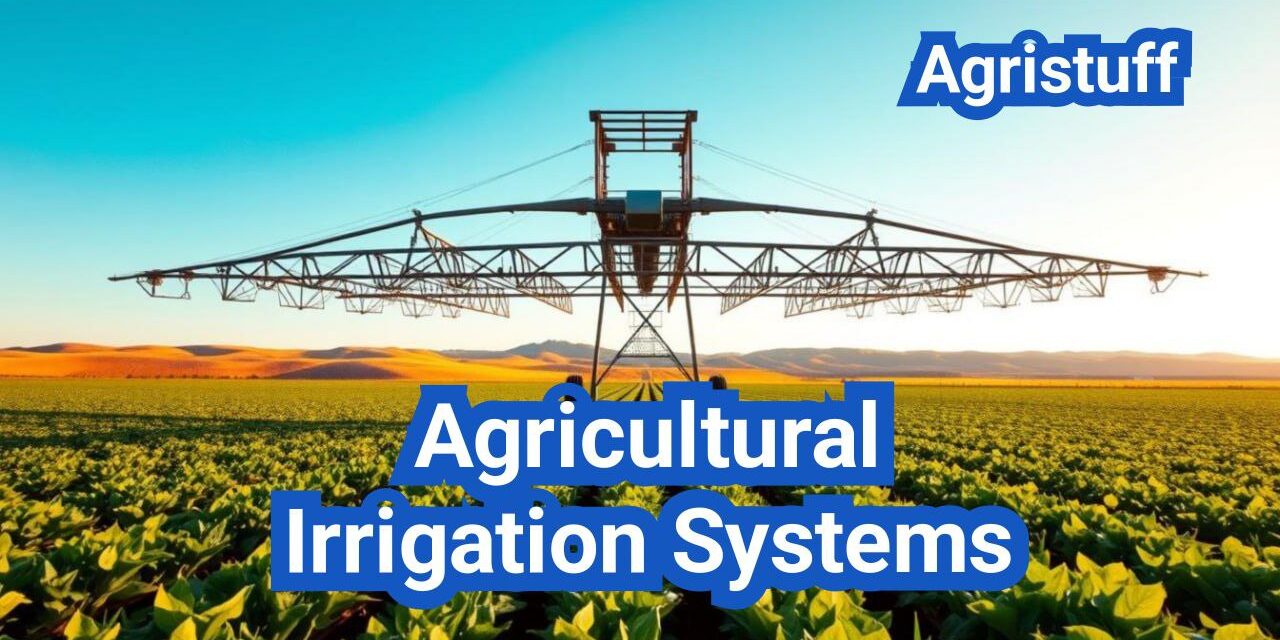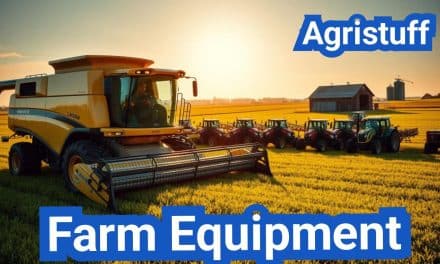Modern agriculture relies heavily on effective irrigation systems to optimize crop yields and reduce water waste. In the United States, farmers irrigated over 53 million acres of cropland in 2023, as reported by the USDA’s latest Irrigation and Water Management Survey.
The choice of irrigation method significantly impacts both the cost and efficiency of farming operations. Various techniques are employed, including drip, pivot, and furrow irrigation, each with its advantages and disadvantages.
Understanding the differences between these farm irrigation systems is crucial for farmers aiming to improve irrigation efficiency and reduce operational costs.
Key Takeaways
- Efficient irrigation is critical for modern agriculture.
- The USDA’s Irrigation and Water Management Survey provides valuable insights into irrigation practices.
- Different irrigation methods have varying costs and efficiencies.
- Choosing the right irrigation system can significantly impact farming operations.
- Improving irrigation efficiency is key to reducing operational costs.
The Critical Role of Irrigation in Modern Agriculture
Modern agriculture heavily relies on irrigation systems to overcome the water-related challenges that farmers in the U.S. face daily. As the backbone of agricultural productivity, irrigation plays a crucial role in ensuring crop yields and farm profitability.
Water Challenges Facing U.S. Farmers Today
U.S. farmers are confronted with numerous water-related challenges, including scarcity, variability in precipitation patterns, and increasing regulatory pressures. According to recent data, U.S. farmers spent nearly $3 billion on irrigation equipment, facilities, land improvements, and computer technology in 2023, underscoring the significance of irrigation in addressing these challenges.
The investment in irrigation infrastructure highlights the efforts of farmers to mitigate water scarcity and ensure a stable water supply for their crops. Effective water management through irrigation is not just a matter of agricultural productivity but also of economic viability for many farming operations.
How Proper Irrigation Impacts Crop Yields and Farm Profitability
Proper irrigation management has a direct impact on crop yields and, consequently, on farm profitability. By ensuring that crops receive the right amount of water at the right time, farmers can significantly enhance their yields and improve the quality of their produce.
The table below illustrates the impact of different irrigation methods on crop yields and farm profitability:
| Irrigation Method | Crop Yield Impact | Profitability Impact |
|---|---|---|
| Drip Irrigation | High yield increase due to precise water application | High profitability due to water savings and reduced labor |
| Center Pivot Irrigation | Moderate yield increase with efficient water use | Moderate profitability with reduced energy costs |
| Furrow Irrigation | Variable yield impact depending on soil type and management | Variable profitability due to potential for water loss and labor requirements |
As the table demonstrates, the choice of irrigation method can have significant implications for both crop yields and farm profitability. By adopting the most appropriate irrigation strategy, farmers can optimize their water use, enhance their yields, and improve their bottom line.
Overview of Agricultural Irrigation Systems

In the United States, farm irrigation has evolved considerably, influenced by factors such as water scarcity and technological innovation. The development of various irrigation systems has been crucial in supporting agricultural productivity across different regions.
Evolution of Farm Irrigation in the United States
Farm irrigation in the U.S. has a rich history, from traditional furrow irrigation to modern center-pivot and drip irrigation systems. The evolution has been driven by the need for more efficient water use and improved crop yields.
Early irrigation methods were often labor-intensive and less efficient. However, with advancements in technology, irrigation systems have become more sophisticated, allowing farmers to manage water resources more effectively.
Key Factors in Irrigation System Selection
Selecting the right irrigation system is critical for farm profitability and water conservation. Several factors influence this decision, including crop type, soil characteristics, and climate conditions.
| Irrigation System | Crop Suitability | Water Efficiency |
|---|---|---|
| Center Pivot | Corn, Soybeans, Wheat | High |
| Drip Irrigation | Fruits, Vegetables, Nuts | Very High |
| Furrow Irrigation | Cotton, Corn, Soybeans | Medium |
The choice of irrigation system can significantly impact both water usage and crop yields. Understanding the strengths and limitations of each system is essential for making informed decisions.
Surface Irrigation Systems: Furrow, Basin, and Border Methods
Surface irrigation systems have been a cornerstone of agricultural water management for centuries, with methods like furrow, basin, and border irrigation remaining widely used today. These traditional techniques continue to play a vital role in modern agriculture, particularly in regions where water conservation is crucial.
Furrow Irrigation: Applications and Limitations
Furrow irrigation is a widely used method, especially for row crops like cotton, soybeans, and corn. This technique involves creating small channels or furrows between crop rows, through which water flows, infiltrating the soil as it moves down the field. The application of furrow irrigation is advantageous in certain terrains and soil types, particularly where the land is relatively flat or has a gentle slope.
However, furrow irrigation also has its limitations. One of the main challenges is water loss due to runoff and deep percolation. According to the USDA, proper field preparation and management practices can significantly reduce these losses. “Effective furrow irrigation management requires careful consideration of factors such as furrow length, slope, and inflow rate to optimize water application and minimize losses.”
Basin and Border Irrigation Techniques
Basin irrigation involves enclosing a field or a portion of a field with levees, creating a basin that is then flooded with water. This method is particularly effective for crops that require standing water, such as rice. Border irrigation, on the other hand, involves dividing a field into strips or borders, separated by levees, and then flooding these strips.
Both basin and border irrigation techniques require precise water management to ensure uniform water distribution and to minimize waterlogging or runoff. The use of precision agriculture technologies can enhance the efficiency of these methods by allowing for more accurate control over water application.
Surge Irrigation and Tailwater Recovery Systems
Surge irrigation is an advanced form of furrow irrigation that involves applying water in intermittent pulses or “surges.” This technique can improve water distribution uniformity and reduce runoff by allowing the soil to absorb water more effectively between surges.
Tailwater recovery systems are another important aspect of surface irrigation management. These systems involve capturing and storing runoff water from irrigation events for later reuse. By implementing tailwater recovery, farmers can significantly reduce water waste and improve the overall efficiency of their irrigation systems.
In conclusion, surface irrigation systems, including furrow, basin, and border methods, remain essential components of agricultural water management. By understanding their applications, limitations, and potential improvements through techniques like surge irrigation and tailwater recovery, farmers can optimize their irrigation practices to conserve water and enhance crop yields.
Sprinkler Irrigation Systems: Center Pivot and Linear Move
The adoption of sprinkler irrigation systems marks a significant advancement in farming technology, enhancing crop yields and reducing water waste. These systems are particularly effective for large-scale farming operations, offering a versatile and efficient means of water distribution.
Center Pivot Irrigation: Operation and Benefits
Center pivot irrigation is a widely used method that involves a lateral move irrigation system rotating around a central pivot point. This technique is particularly effective in large, generally flat fields and is commonly used for crops like cotton, corn, soybeans, and wheat.
“Center pivot irrigation has revolutionized the way we farm, allowing us to cultivate larger areas with less labor and water,” says a farmer from Nebraska. The system’s ability to deliver water uniformly across the field reduces runoff and deep percolation losses, making it an efficient choice for many farmers.
Linear Move Systems for Rectangular Fields
Linear move systems are another type of sprinkler irrigation that moves in a straight line across the field, making them ideal for rectangular fields. These systems are highly efficient and can be equipped with advanced technologies like GPS and variable rate irrigation (VRI) to optimize water application.
Linear move systems offer several benefits, including reduced soil compaction and improved crop yields due to uniform water distribution. They are particularly useful for crops that are sensitive to overwatering or require precise moisture levels.
Solid Set and Portable Sprinkler Options
In addition to center pivot and linear move systems, solid set and portable sprinkler systems offer flexible irrigation solutions for various agricultural applications. Solid set systems involve permanently installed sprinklers, while portable systems can be moved between fields or seasons.
These systems are beneficial for crops that require more precise water application, such as orchards and vineyards. They also offer the advantage of being able to irrigate fields with irregular shapes or topography.
Energy Requirements and Water Application Rates
The energy requirements for sprinkler irrigation systems vary depending on the type and size of the system, as well as the water source and pressure requirements. Center pivot and linear move systems typically require significant energy to operate, especially for larger systems.
Water application rates are critical in determining the efficiency of sprinkler irrigation systems. Factors such as nozzle size, pressure, and spacing between sprinklers all impact the uniformity of water distribution. Proper design and maintenance are essential to minimize evaporation losses and ensure that crops receive adequate moisture.
Drip Irrigation Systems: Maximizing Water Efficiency

Drip irrigation systems have revolutionized the way farmers manage water resources, offering a highly efficient method for crop irrigation. By delivering water directly to the roots of plants, these systems significantly reduce runoff and evaporation, making them an ideal choice for water-conscious farming practices.
Surface Drip Irrigation Design and Components
Surface drip irrigation involves laying drip lines on the soil surface, delivering water directly to the plant roots. This method is particularly effective for crops like vegetables and fruits. The key components of surface drip irrigation systems include:
- Drip emitters or drippers that release water at a controlled rate
- Drip lines or laterals that distribute water along the crop rows
- Filters to prevent clogging of the emitters
- Pressure regulators to maintain optimal pressure
- Valves for controlling water flow
These components work together to ensure that water is delivered efficiently to the crops, minimizing waste and reducing the risk of overwatering.
Subsurface Drip Irrigation (SDI) Implementation
Subsurface drip irrigation involves burying drip lines beneath the soil surface, typically at a depth of 6-12 inches. This method offers several advantages, including reduced evaporation and improved water use efficiency. SDI is particularly beneficial for crops with deep root systems and can be used in a variety of soil types.
Implementing SDI requires careful planning, including:
- Soil assessment to determine the optimal depth for drip line placement
- Selection of appropriate drip line materials and emitters
- Installation of the drip lines at the correct depth and spacing
- Regular maintenance to prevent clogging and ensure system longevity
Micro-Sprinkler and Micro-Spray Applications
Micro-sprinklers and micro-sprays are variations of drip irrigation that use small sprinkler or spray nozzles to distribute water. These systems are often used for orchards and vineyards, where they provide effective coverage for trees and vines.
The benefits of micro-sprinkler and micro-spray systems include:
- Improved coverage for wider crop spacing
- Flexibility in application, allowing for adjustment based on crop needs
- Reduced soil erosion compared to traditional sprinkler systems
Filtration Requirements for Drip Systems
Filtration is a critical component of drip irrigation systems, as it prevents clogging of the emitters and ensures uniform water distribution. The type of filtration required depends on the water source and the specific system design.
Common filtration methods for drip irrigation include:
- Screen filters for removing larger particles
- Media filters for filtering out smaller particles and contaminants
- Disc filters for effective filtration in a variety of water conditions
Regular maintenance of the filtration system is essential to ensure the longevity and efficiency of the drip irrigation system.
Head-to-Head Comparison of Major Irrigation Systems
Understanding the strengths and weaknesses of various irrigation systems is key to making informed decisions in agricultural water management. Different irrigation systems offer unique advantages and disadvantages, making it essential to compare them directly.
Water Efficiency and Conservation Potential
Water efficiency is a critical factor in irrigation system selection. Drip irrigation systems are known for their high water efficiency, as they deliver water directly to the roots of plants, minimizing evaporation and runoff.
In contrast, center pivot irrigation systems, while highly effective for large areas, can have varying levels of water efficiency depending on their design and operation.
Furrow irrigation, a traditional method, can be less efficient due to potential runoff and evaporation, but it remains widely used due to its simplicity and low initial cost.
Labor Requirements and Automation Possibilities
Labor requirements vary significantly among irrigation systems. Drip irrigation systems, while potentially labor-intensive to install, can be highly automated, reducing ongoing labor needs.
Center pivot systems are also highly automatable, with many modern systems featuring advanced technology for precise water application and minimal manual intervention.
Furrow irrigation typically requires more labor for setup and management, although some automation is possible with surge irrigation techniques.
Crop Suitability and Limitations | Agricultural Irrigation Systems
Different crops have varying irrigation needs and tolerances. Drip irrigation is suitable for a wide range of crops, particularly those that are sensitive to waterlogging or require precise water application.
Center pivot systems are versatile and can be used for various crops, including corn, soybeans, and alfalfa, but may not be ideal for crops that are highly sensitive to water stress or require very precise watering.
Furrow irrigation is commonly used for row crops and can be effective for crops like corn and beans, but may not be suitable for crops that are sensitive to flooding.
Terrain Adaptability | Agricultural Irrigation Systems
The adaptability of an irrigation system to different terrains is crucial for its effectiveness. Drip irrigation systems can be used on a variety of terrains, including sloping lands, with proper design.
Center pivot systems are generally best suited for relatively flat or gently sloping terrains, although some models can handle more complex topography.
Furrow irrigation can be used on a range of terrains but is most effective on relatively flat or gently sloping lands.
Advanced Irrigation Technologies Transforming Farming

Advanced irrigation technologies are redefining the future of agriculture, enabling farmers to optimize water use and improve crop yields. These innovations are crucial for addressing the challenges faced by modern farmers, including water scarcity, energy efficiency, and environmental sustainability.
Mobile Drip Irrigation (MDI) Systems
Mobile Drip Irrigation (MDI) systems represent a significant advancement in irrigation technology. By combining the benefits of drip irrigation with the flexibility of center pivot systems, MDI delivers water directly to the root zone of crops, reducing evaporation and runoff. This technology is particularly beneficial for crops that require precise water application, such as corn and soybeans.
LEPA vs. LESA: Low Energy Precision Application Methods
Low Energy Precision Application (LEPA) and Low Elevation Spray Application (LESA) are two irrigation methods that have gained popularity for their efficiency and water-saving potential. LEPA involves delivering water directly to the soil surface or crop root zone, minimizing evaporation losses. LESA, on the other hand, applies water at a lower elevation than traditional sprinkler systems, reducing drift and evaporation. Both methods are designed to optimize water use and reduce energy consumption.
Variable Rate Irrigation (VRI) Technology
Variable Rate Irrigation (VRI) technology allows farmers to vary the application rate of water across a field based on specific conditions, such as soil type, topography, and crop requirements. This precision irrigation technique ensures that each area of the field receives the optimal amount of water, improving overall efficiency and reducing waste.
- VRI technology can be integrated with soil moisture sensors and weather data to optimize irrigation scheduling.
- It enables farmers to manage variability within fields more effectively, potentially increasing crop yields and reducing environmental impact.
Smart Controllers and Automation Solutions | Agricultural Irrigation Systems
Smart controllers and automation solutions are revolutionizing irrigation management by providing real-time monitoring and control capabilities. These systems can be integrated with various data sources, including weather stations, soil moisture sensors, and crop models, to optimize irrigation decisions. Automation solutions reduce labor requirements and improve the precision of irrigation applications, leading to enhanced water conservation and crop productivity.
By embracing these advanced irrigation technologies, farmers can significantly improve their operational efficiency, reduce their environmental footprint, and contribute to a more sustainable agricultural future.
Measuring and Improving Irrigation Efficiency

As global water resources become increasingly strained, improving irrigation efficiency has become a pressing concern for farmers worldwide. Effective irrigation systems are crucial not only for crop yields but also for conserving water and reducing environmental impact.
Understanding Distribution Uniformity | Agricultural Irrigation Systems
Distribution uniformity is a critical measure of irrigation efficiency, reflecting how evenly water is applied across the field. High distribution uniformity ensures that all areas receive adequate moisture, minimizing both under-watering and over-watering. Factors influencing distribution uniformity include system design, nozzle selection, and operating pressure.
Application Efficiency Measurement Techniques
Application efficiency refers to the percentage of water applied that is actually used by the crop. Techniques to measure application efficiency include soil moisture monitoring, catch-can tests, and flow meters. By accurately measuring application efficiency, farmers can identify areas for improvement and optimize their irrigation systems.
Water Use Efficiency Strategies | Agricultural Irrigation Systems
Improving water use efficiency involves a combination of strategies, including adopting drip irrigation or other precision irrigation methods, implementing soil moisture monitoring, and using crop varieties that are more water-efficient. Additionally, practices like mulching and cover cropping can help reduce soil evaporation and improve water retention.
Reducing Runoff and Deep Percolation Losses
Runoff and deep percolation are significant sources of water loss in irrigation systems. Strategies to mitigate these losses include adjusting irrigation schedules based on soil moisture levels, using surge irrigation to reduce runoff, and implementing tailwater recovery systems to capture and reuse runoff water.
Comprehensive Cost Analysis of Farm Irrigation Systems
Understanding the financial implications of different irrigation systems is crucial for farmers to make informed decisions. The costs associated with farm irrigation systems can be broadly categorized into initial installation expenses, operational and maintenance costs, energy requirements, and long-term return on investment (ROI) comparisons.
Initial Installation Expenses by System Type
The initial investment for irrigation systems varies significantly based on the type and scale of the system. For instance, drip irrigation systems typically require a higher upfront investment due to the complexity of their design and the materials used. In contrast, furrow irrigation systems may have lower initial costs but could have higher operational expenses.
A detailed breakdown of initial installation costs for different irrigation systems is essential for farmers to plan their investments effectively. The costs can range from $500 to $2,500 per acre, depending on the system type and technology level.
Operational and Maintenance Costs | Agricultural Irrigation Systems
Operational and maintenance costs are ongoing expenses that farmers must consider when evaluating the total cost of ownership of an irrigation system. These costs include labor, maintenance of equipment, and energy costs for pumping water.
For example, center pivot irrigation systems require regular maintenance to ensure uniform water distribution and to prevent mechanical failures. The cost of maintaining these systems can vary, but on average, it ranges from $10 to $50 per acre per year.
Energy Requirements and Cost Considerations
Energy costs are a significant component of the operational expenses for irrigation systems, particularly for systems that require pumping water over long distances or to high elevations. The energy requirements can vary widely depending on the type of irrigation system and the water source.
For instance, submersible pumps used in drip irrigation systems can have high energy demands, contributing to higher operational costs. Farmers should consider energy-efficient options and explore alternative energy sources, such as solar power, to reduce these costs.
Long-term ROI Comparison | Agricultural Irrigation Systems
When evaluating different irrigation systems, farmers should consider the long-term return on investment (ROI). While some systems may have higher upfront costs, they may offer better water efficiency and lower operational costs over time, leading to a higher ROI.
A comparative analysis of the ROI for different irrigation systems can help farmers make informed decisions. For example, a study comparing the ROI of drip irrigation versus center pivot irrigation systems over a 10-year period can provide valuable insights into which system offers better long-term financial benefits.
Scientific Irrigation Scheduling Methods

Scientific irrigation scheduling methods have revolutionized the way farmers manage water resources. These methods enable farmers to optimize water application, reduce waste, and improve crop yields.
Evapotranspiration (ETc) Based Scheduling | Agricultural Irrigation Systems
Evapotranspiration (ETc) based scheduling is a widely adopted method that calculates the water lost through evaporation and transpiration from the soil and plants. By understanding ETc rates, farmers can determine the exact amount of water needed for their crops.
ETc-based scheduling involves using weather data, crop coefficients, and soil type to estimate water loss. This method allows for precise irrigation planning, reducing the risk of overwatering or underwatering.
“ETc-based irrigation scheduling has been shown to reduce water usage by up to 20% in some crops, while maintaining or even increasing yields.” –
Agricultural Water Management Journal
Soil Moisture Sensors and Monitoring Systems
Soil moisture sensors play a crucial role in irrigation scheduling by providing real-time data on soil moisture levels. These sensors help farmers make informed decisions about when to irrigate.
- Capacitance sensors measure the dielectric constant of the soil, providing an accurate estimate of soil moisture.
- Tensiometers measure the soil water tension, indicating the energy required by plants to extract water from the soil.
Soil moisture monitoring systems can be integrated with irrigation controllers to automate the irrigation process based on actual soil conditions.
Weather-Based Irrigation Controllers | Agricultural Irrigation Systems
Weather-based irrigation controllers use real-time weather data to adjust irrigation schedules. These controllers can significantly reduce water waste by avoiding irrigation during rainy or high-humidity periods.
| Weather Parameter | Impact on Irrigation |
|---|---|
| Rainfall | Reduces or skips irrigation |
| Temperature | Adjusts irrigation based on evapotranspiration rates |
| Humidity | Reduces irrigation during high humidity |
Deficit Irrigation Strategies | Agricultural Irrigation Systems
Deficit irrigation involves applying less water than the crop’s full evapotranspiration needs. This strategy can be effective for certain crops, improving water productivity and reducing costs.
Deficit irrigation requires careful planning and monitoring to ensure that the water stress does not negatively impact crop yields. It’s particularly useful for drought-tolerant crops or in areas with limited water resources.
Step-by-Step Guide to Implementing a New Irrigation System

Implementing a new irrigation system requires careful planning and execution to ensure optimal water use and crop yield. This guide will walk you through the essential steps to successfully implement an irrigation system that meets your farm’s specific needs.
Site Assessment and System Design | Agricultural Irrigation Systems
The first step in implementing a new irrigation system is conducting a thorough site assessment. This involves evaluating the topography, soil type, and existing infrastructure to determine the most suitable irrigation method. Proper site assessment is critical for identifying potential challenges and opportunities for improvement.
During the site assessment, consider factors such as:
- Soil texture and structure
- Field slope and elevation changes
- Existing water sources and infrastructure
- Crop selection and rotation patterns
Once the site assessment is complete, the next step is to design the irrigation system. This involves selecting the appropriate irrigation components, such as pumps, pipes, and emitters, and configuring them to meet the specific needs of your farm.
Installation Process and Best Practices | Agricultural Irrigation Systems
The installation process is a critical phase in implementing a new irrigation system. It is essential to follow best practices to ensure that the system is installed correctly and functions as intended.
Key considerations during installation include:
- Properly sizing and installing pipes and fittings
- Correctly positioning and securing irrigation components
- Ensuring adequate drainage and water management
- Testing the system for leaks and other issues
System Testing and Calibration | Agricultural Irrigation Systems
After installation, the irrigation system must be thoroughly tested and calibrated to ensure it is functioning correctly. This involves checking the system’s performance under various operating conditions and making any necessary adjustments.
| Test Parameter | Acceptable Range | Actual Reading |
|---|---|---|
| Flow Rate | 90-110 GPM | 100 GPM |
| Pressure | 30-50 PSI | 40 PSI |
| Uniformity Coefficient | >90% | 92% |
Training and Operational Guidelines | Agricultural Irrigation Systems
Finally, it is crucial to provide training on the operation and maintenance of the new irrigation system. This includes educating farm staff on how to properly use and maintain the system, as well as troubleshooting common issues.
Operational guidelines should cover:
- Scheduling irrigation events
- Monitoring system performance
- Performing routine maintenance tasks
- Addressing common problems and emergencies
By following this step-by-step guide, farmers can ensure a successful irrigation system implementation that improves water use efficiency and crop yields.
Troubleshooting Common Irrigation System Problems
Troubleshooting irrigation systems is essential to address common issues that affect their efficiency and overall farm productivity. Irrigation systems are complex and can be affected by various factors, including design, installation, maintenance, and environmental conditions.
Pressure and Flow Issues | Agricultural Irrigation Systems
Pressure and flow issues are common problems in irrigation systems. These issues can lead to uneven water distribution, reduced crop yields, and increased energy costs. Causes include:
- Incorrect pump sizing
- Clogged or damaged pipes
- Air leaks in the system
- Improper valve settings
To address these issues, farmers should regularly inspect their irrigation systems, checking for signs of wear or damage, and ensure that pumps and valves are properly sized and maintained.
Clogging and Filtration Problems | Agricultural Irrigation Systems
Clogging is another significant issue in irrigation systems, particularly in drip irrigation. Clogging can be caused by physical particles, chemical precipitates, or biological growth. Effective filtration is crucial to prevent clogging.
- Use appropriate filters for the type of irrigation system
- Regularly clean and maintain filters
- Monitor water quality to prevent chemical and biological clogging
Distribution Uniformity Challenges | Agricultural Irrigation Systems
Distribution uniformity refers to how evenly water is applied across the field. Poor distribution uniformity can lead to overwatering in some areas and underwatering in others. Factors affecting distribution uniformity include:
- System design and layout
- Emitter spacing and type
- Pressure variations
Improving distribution uniformity may involve adjusting the system design, using pressure-regulating devices, and ensuring proper emitter spacing.
Weather-Related Adjustments | Agricultural Irrigation Systems
Weather conditions significantly impact irrigation needs. Farmers must adjust their irrigation schedules according to weather forecasts to avoid overwatering or wasting water. This includes:
- Reducing irrigation during rainy periods
- Increasing irrigation during hot, dry spells
- Using weather-based irrigation controllers
By making these adjustments, farmers can optimize water use, reduce waste, and improve crop health.
Funding and Support for Irrigation Improvements

The United States offers numerous initiatives to support farmers in enhancing their irrigation systems, promoting water conservation and efficiency. These programs are crucial for farmers looking to adopt more efficient irrigation technologies and practices.
NRCS EQIP Irrigation Assistance Programs | Agricultural Irrigation Systems
The Natural Resources Conservation Service (NRCS) provides financial and technical assistance to farmers through the Environmental Quality Incentives Program (EQIP). This program helps farmers implement conservation practices, including irrigation improvements. NRCS EQIP irrigation assistance is designed to support farmers in adopting efficient irrigation systems, such as drip irrigation and center pivot systems, which can significantly reduce water usage.
Farmers can receive financial assistance to implement irrigation conservation practices, such as improving irrigation system design, installing new irrigation equipment, and adopting water-saving technologies.
State-Level Water Conservation Incentives | Agricultural Irrigation Systems
In addition to federal programs, many states offer their own incentives for water conservation and irrigation efficiency. These incentives can include grants, low-interest loans, and technical assistance. For example, some states provide rebates for farmers who adopt efficient irrigation technologies or implement water-saving practices.
State-level water conservation incentives play a vital role in supporting farmers’ efforts to improve irrigation efficiency and reduce water waste. By taking advantage of these programs, farmers can offset the costs associated with upgrading their irrigation systems.
Tax Benefits for Irrigation Efficiency Upgrades | Agricultural Irrigation Systems
Farmers may also be eligible for tax benefits when they upgrade their irrigation systems to more efficient models. The IRS offers tax credits and deductions for conservation practices, including irrigation improvements. These tax benefits can help offset the costs of adopting new irrigation technologies.
To qualify for these tax benefits, farmers should consult with a tax professional to ensure they meet the necessary requirements and follow the proper procedures for claiming these incentives.
Water District Programs and Resources | Agricultural Irrigation Systems
Local water districts often provide additional resources and support for farmers looking to improve their irrigation efficiency. These programs can include technical assistance, water management planning, and financial incentives for adopting water-saving practices.
By leveraging water district programs and resources, farmers can gain valuable insights into optimizing their irrigation systems and reducing water usage. These local initiatives can be a crucial component of a comprehensive irrigation improvement strategy.
Case Studies: Successful Agricultural Irrigation Systems
The effectiveness of irrigation systems varies widely, with case studies showing diverse applications across different farm types. These real-world examples provide valuable insights into the benefits and challenges of various irrigation methods.
Small Farm Success with Drip Irrigation | Agricultural Irrigation Systems
Drip irrigation has proven to be particularly beneficial for small farms, where water conservation is crucial. By delivering water directly to the roots of plants, drip irrigation reduces evaporation and runoff, leading to significant water savings.
A case study of a small farm in California demonstrated that switching to drip irrigation resulted in a 40% reduction in water usage and a 25% increase in crop yield. The farm was able to maintain soil health and reduce labor costs associated with traditional irrigation methods.
Large-Scale Operations with Center Pivot Systems
Center pivot irrigation systems are widely used in large-scale farming operations due to their efficiency and ability to cover vast areas. These systems are particularly effective for crops like corn and soybeans.
A Nebraska farm implemented a center pivot system, achieving a 30% increase in crop yields while reducing water consumption by 20%. The system’s precision application capabilities allowed for better soil moisture management, leading to improved crop health.
| Irrigation System | Water Savings | Crop Yield Increase |
|---|---|---|
| Drip Irrigation | 40% | 25% |
| Center Pivot | 20% | 30% |
| Mixed Approach | 35% | 40% |
Mixed Approach for Diverse Crop Requirements | Agricultural Irrigation Systems
Some farms have successfully adopted a mixed irrigation approach, combining different systems to meet the diverse needs of various crops. This flexibility allows farmers to optimize water use and improve crop yields across their operations.
A farm in Texas implemented a combination of drip irrigation for high-value crops and center pivot systems for larger fields. This mixed approach resulted in an overall water savings of 35% and a 40% increase in total crop yield.
By examining these case studies, it’s clear that the right irrigation system or combination of systems can significantly impact agricultural productivity and water conservation.
Selecting the Right Irrigation System for Your Farm
Selecting the right irrigation system is crucial for optimizing crop yields and reducing water waste. Factors such as crop type, farm size, and water availability play a significant role in determining the most suitable irrigation system for your farm.
By understanding the different types of irrigation systems, including drip, pivot, and furrow irrigation, farmers can make informed decisions about their irrigation needs. Advanced technologies like Variable Rate Irrigation (VRI) and Mobile Drip Irrigation (MDI) offer opportunities for improved water efficiency and reduced energy costs.
When choosing an irrigation system, consider the initial installation expenses, operational and maintenance costs, and long-term ROI. Assessing your farm’s specific needs and consulting with irrigation experts can help ensure the selected system meets your requirements.
Effective irrigation system selection involves balancing water conservation, energy efficiency, and crop productivity. By applying the knowledge gained from this article, farmers can optimize their irrigation practices and contribute to a more sustainable agricultural future.
FAQ
What are the main types of irrigation systems used in agriculture?
The main types of irrigation systems used in agriculture are surface irrigation, sprinkler irrigation, and drip irrigation. Each has its own advantages and is suited to different crops, soil types, and farm sizes.
How do I choose the right irrigation system for my farm?
Choosing the right irrigation system depends on several factors including crop type, soil characteristics, climate, water availability, and farm size. It’s essential to assess these factors and consider the initial investment, operating costs, and potential water savings.
What is the difference between center pivot and linear move irrigation systems?
Center pivot irrigation systems rotate around a central pivot point, irrigating a circular area, while linear move systems move in a straight line, typically used for rectangular fields. Center pivots are more common and can be more cost-effective for large areas.
How does drip irrigation compare to sprinkler irrigation in terms of water efficiency?
Drip irrigation is generally more water-efficient than sprinkler irrigation because it delivers water directly to the roots of the plants, reducing evaporation and runoff. However, the actual water savings depend on the design, management, and maintenance of the system.
What are the benefits of using subsurface drip irrigation (SDI)?
Subsurface drip irrigation (SDI) offers several benefits, including reduced evaporation, minimized soil erosion, and potentially higher crop yields due to consistent soil moisture levels. It’s particularly useful for crops that are sensitive to wet conditions.
How can I improve the efficiency of my existing irrigation system?
Improving irrigation efficiency can be achieved through proper maintenance, adjusting irrigation schedules based on weather and soil moisture conditions, and potentially upgrading to more efficient technologies like precision irrigation or smart controllers.
What are the key factors to consider when evaluating the cost of an irrigation system?
When evaluating the cost of an irrigation system, consider the initial installation cost, ongoing operational and maintenance expenses, energy requirements, and potential water savings. It’s also important to assess the system’s impact on crop yields and overall farm profitability.
Are there any government programs or incentives available for improving irrigation efficiency?
Yes, there are government programs and incentives available to support irrigation efficiency improvements. These include NRCS EQIP programs, state-level water conservation incentives, and tax benefits for irrigation upgrades. Farmers should check with local agricultural authorities for specific programs available in their area.
How can I determine the distribution uniformity of my irrigation system?
Distribution uniformity can be determined by measuring the water application rates across the irrigated area. This involves using catch cans or other measurement tools to assess how evenly water is being distributed. Regular checks can help identify issues and guide adjustments to improve uniformity.
What role does evapotranspiration (ETc) play in irrigation scheduling?
Evapotranspiration (ETc) is a critical factor in irrigation scheduling as it represents the amount of water used by crops. By using ETc data, farmers can schedule irrigation to match the actual water needs of their crops, optimizing water use and potentially improving crop yields.
Conclusion of: Agricultural Irrigation Systems
Why comparing agricultural irrigation systems matters right now
Choosing between agricultural irrigation systems is one of the most consequential decisions a U.S. grower can make, because it locks in water use, energy spend, labor needs, and yield potential for a decade or more; the scale of irrigation’s freshwater withdrawals makes smart choices both profitable and responsible. USGS: Water use overview
How this guide compares agricultural irrigation systems
This guide compares agricultural irrigation systems—drip (including subsurface drip), center-pivot sprinklers, and gravity/furrow—across application efficiency, distribution uniformity, capital and operating costs, energy, labor, filtration needs, and field-shape constraints, so you can match technology to your acres rather than forcing acres to fit the technology. USDA NRCS: Irrigation Guide (overview)
A U.S. snapshot to frame agricultural irrigation systems
Recent national surveys show that agricultural irrigation systems, methods, and scheduling vary widely by state and crop, which is why regional benchmarks—acre-inches applied, energy per acre-inch, and timing—matter when you evaluate upgrades or conversions on your farm. USDA NASS: Irrigation & Water Management Survey
Key efficiency concepts for agricultural irrigation systems
When comparing agricultural irrigation systems, keep three terms straight: application efficiency (percent of applied water stored in the root zone), distribution uniformity (how evenly water is applied), and seasonal efficiency (whole-season performance), because misusing these concepts leads to poor designs and wasteful schedules. Colorado State Extension: Irrigation water management
Typical efficiency ranges across agricultural irrigation systems
Under sound design and management, agricultural irrigation systems usually fall into these ranges: surface/furrow about 50–80% (highly variable), center-pivot sprinklers around 80–92% (package-dependent), and microirrigation/drip roughly 90–95%+, with wind, pressure regulation, soil intake, and maintenance determining where your system actually lands. Washington Dept. of Ecology: Determining irrigation efficiency
Drip & subsurface drip (SDI): how this agricultural irrigation system works
Among agricultural irrigation systems, drip applies low-rate water directly to the root zone through emitters, wetting only the soil that matters and reducing evaporation; subsurface drip (SDI) buries laterals to further cut surface losses and keep traffic lanes dry for timely field operations. FAO: Drip irrigation basics
Drip performance within agricultural irrigation systems
In well-managed agricultural irrigation systems, drip—especially SDI—delivers high application efficiency and strong distribution uniformity when filtration is right and scheduling follows crop demand, often translating into fewer pumped inches per unit of yield and precise nutrient placement via fertigation. Texas A&M AgriLife: Drip for row crops
Costs for drip/SDI in agricultural irrigation systems
Compared with other agricultural irrigation systems, SDI typically requires more up-front dollars per acre due to laterals, filtration, injection equipment, and careful installation, yet economics improve with high-value crops, irregular fields, longer system life, and limited water allocations that reward high efficiency. Kansas State University: SDI resources & economics
Filtration & clogging: the make-or-break factor for drip agricultural irrigation systems
The weak link in drip-based agricultural irrigation systems is emitter clogging from sediment, precipitates, organics, and biofilm, which is why proper filtration, routine flushing, and water-chemistry management are non-negotiable to protect distribution uniformity and yield. UC ANR: Maintaining microirrigation systems
Where drip/SDI fits best among agricultural irrigation systems
Drip excels within agricultural irrigation systems when water is scarce, field shapes are irregular, salinity risks exist, or crop value justifies precision fertigation and lower foliar disease risk from drier canopies, making orchards, vines, vegetables, and high-value row crops strong candidates. UC ANR: Drip irrigation & salinity management
Center-pivot sprinklers: what this agricultural irrigation system looks like
Center-pivots are mechanized agricultural irrigation systems that rotate around a fixed point, with sprinkler packages ranging from low-pressure sprays on drops to LESA/LEPA options, and the chosen package governs both application efficiency and pumping energy per acre-inch. UNL CropWatch: Irrigation hub
Efficiency potential for center-pivot agricultural irrigation systems
Modern center-pivot agricultural irrigation systems equipped with in-canopy, low-pressure nozzles and good pressure regulation can approach ~90% application efficiency while minimizing wind drift and evaporation, provided nozzle sizing matches soil intake and sets are timed to crop demand. Colorado State Extension: Reduce sprinkler losses
LESA/LEPA & mobile-drip options on center-pivot agricultural irrigation systems
Upgrading center-pivot agricultural irrigation systems with LESA/LEPA packages or mobile-drip lines drops application height to the canopy or furrow, curbing drift and evaporation and potentially lifting efficiency into the 90s under the right soil and slope conditions. Oklahoma State Extension: LEPA systems
Costs & energy for center-pivot agricultural irrigation systems
On quarter-section or larger fields, center-pivot agricultural irrigation systems often deliver favorable dollars-per-acre coverage, and lower-pressure packages reduce kilowatt-hours per acre-inch; always pencil in well depth, total dynamic head, tariff structure, and variable-frequency drives before purchasing. USDA ERS: Irrigation economics
Field shape & corners when siting center-pivot agricultural irrigation systems
Center-pivot agricultural irrigation systems are most cost-effective on square or circular fields; rectangles or obstacle-laden tracts leave unirrigated corners unless you add end guns or corner arms, so include corner acres and any uniformity impacts in your ROI comparisons. Washington State University: Irrigation tools & resources
Gravity/furrow: how surface agricultural irrigation systems work
Surface agricultural irrigation systems move water by gravity in furrows, borders, or basins, with performance hinging on inflow rate, intake variability, slope, and tailwater handling; with good design and automation, surface systems can be competitive where water is inexpensive and slopes are gentle. USDA NRCS: Engineering technical guides
Efficiency & upgrades for furrow-based agricultural irrigation systems
Within furrow-based agricultural irrigation systems, surge valves, better cutoff timing, and tailwater recovery reduce deep percolation and runoff, lifting application efficiency into the competitive range and improving yields where uniform infiltration is hard to achieve. Washington Dept. of Ecology: Efficiency concepts
Costs & labor for furrow agricultural irrigation systems
Furrow agricultural irrigation systems usually have the lowest capital cost—gated pipe, ditches, and valves—but demand more labor and careful scheduling; lowering applied inches through improved cutoff strategies can pay back in a single season via energy savings. UNL CropWatch: Surface irrigation practice
Scheduling is the force multiplier across agricultural irrigation systems
Regardless of equipment, agricultural irrigation systems live or die by scheduling—aligning irrigation with crop evapotranspiration (ETc) and soil water status—so use local ETo networks and crop coefficients to keep water in the root zone and cuts in pumping hours credible. FAO-56: Crop evapotranspiration
Soil-moisture sensors that fit agricultural irrigation systems
Capacitance/FDR probes, TDR, and matric-potential sensors (tensiometers/granular matrix) help agricultural irrigation systems trigger irrigations from data instead of guesswork; install at multiple depths in representative zones and validate with hand-feel or gravimetric checks. University of Minnesota Extension: Sensor types & use
Energy management within agricultural irrigation systems
Energy per acre-inch in agricultural irrigation systems depends on total dynamic head and required pressure, so keep filters clean on drip, lower nozzle pressure and drop height on pivots where agronomically sound, and consider off-peak pumping if your utility tariff rewards it. USDA ERS: Cost & efficiency levers
Field-shape decision matrix for agricultural irrigation systems
A practical rule for agricultural irrigation systems is: choose center-pivot for large, square commodity acres where automation matters; choose drip/SDI for high-value crops, irregular fields, saline contexts, and tight water budgets; retain or upgrade furrow where water is inexpensive and labor is available, adding surge and tailwater capture to boost performance. USDA NRCS: System selection guidance
Programs that help pay for better agricultural irrigation systems
Cost-share programs can de-risk upgrades to agricultural irrigation systems; NRCS EQIP and related initiatives often fund microirrigation conversions, sprinkler-package improvements, variable-frequency drives, and documented water-management practices that deliver measurable savings. USDA NRCS: EQIP program
Weather & ET networks that support agricultural irrigation systems
Regional ET networks and scheduling tools provide daily crop water-use estimates that make agricultural irrigation systems more precise and less energy-intensive when paired with in-field sensors and soil maps, tightening the link between pumping hours and plant demand. U.S. Bureau of Reclamation: AgriMet ET
Real-world benchmarking for agricultural irrigation systems
Validate agricultural irrigation systems with simple tests: catch-can evaluations on pivots, pressure checks at line ends, and drip flush records to keep distribution uniformity high; then track inches applied vs. ETc and yield to prove ROI to lenders and qualify for conservation incentives. UNL CropWatch: Testing & evaluation
Example—raising performance in furrow agricultural irrigation systems
Even if you stay with furrow inside your mix of agricultural irrigation systems, dialing in cutoff timing, adding surge valves where suitable, and reusing tailwater can trim deep percolation and runoff, yielding fast payback through lower energy per harvested bushel. Colorado State Extension: Scheduling & cutoff
Final thought
The best fit among agricultural irrigation systems is the one you can manage reliably for your field shape, crop rotation, water allocation, power rates, and labor. Start with conservative, verifiable scheduling (ET + sensors), choose the highest-efficiency package you can maintain, and use land-grant and NRCS tools to model costs before you buy—so every pumped inch and kilowatt returns value. USDA NRCS: Plan & design resources
Sources & References
- USGS – Water Use in the United States
- Washington Dept. of Ecology – Determining Irrigation Efficiency
- FAO – Drip Irrigation Basics
- Kansas State University – SDI Resources
- UC ANR – Maintaining Microirrigation Systems
- UC ANR – Drip Irrigation & Salinity Management
- USDA ERS – Irrigation & Water Use
- U.S. Bureau of Reclamation – AgriMet ET Network
- University of Minnesota Extension – Soil-Moisture Sensors
- Washington State University – Irrigation Tools & Engineering Resources










